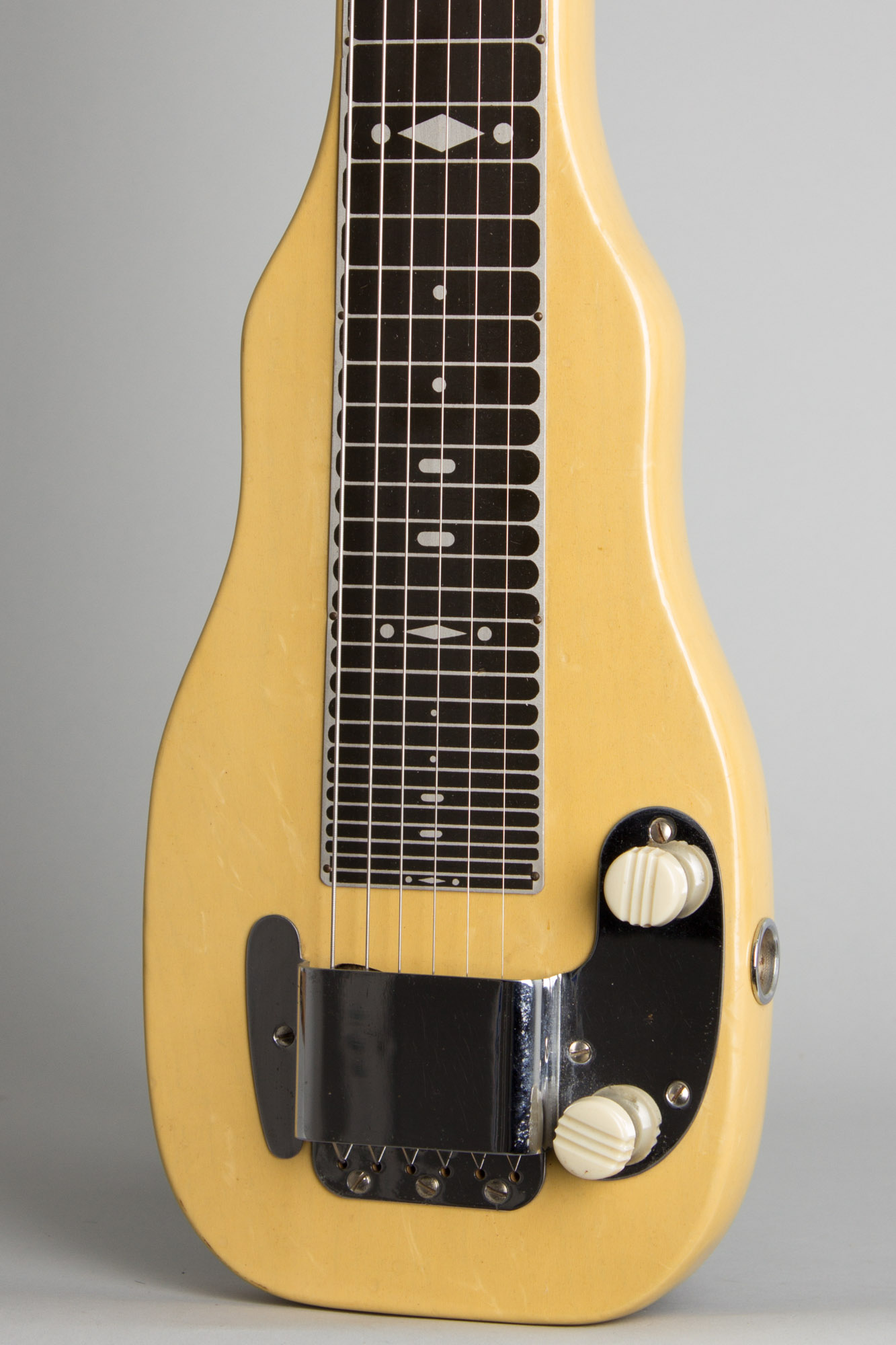

The guitars were typically sold in combination with a matching amplifier. All had a headstock that was sort of like a simplified mini-Gibson design, with a center peak at the top. It was dressed in “pearl Lumarith” (a tan-colored pearloid) and sported “tinsel” (sparkle plastic) fingerboard inlays and trim. Both had decal fingerboards and were covered in a silver-grey pearloid they are the most commonly seen. Pre-war Dickersons had a relatively heavy cast tailpiece, whereas post-war models used the metal rod combined with the through-body grommets. The Standard sported top-mounted controls and added a Tone. The Student was pear-/paddle-shaped and had a handrest with a Volume control mounted on it. Hawaiian guitar wizard Sol Hoopii, who was teaching Dickerson’s daughter, Belva, reportedly consulted on the design of these guitars – the Student, the Standard, and the De Luxe – all of which had a single-coil pickup mounted underneath their top in a design he patented (filed 1938, awarded 1940). This is the kind of infrastructure that fed Dickerson, or vice versa!ĭickerson appears to have offered three Hawaiian guitars and four amps, sold in sets. A second crew would circle by to pick up the kids and transport them to the AHT for lessons. The hawker got a fee and the organization no doubt got a cut of the teacher’s pay. They might also offer instruments that the family could either rent or buy.

and other larger cities, teachers often joined a larger organization such as the AHT, which would send salespeople door-to-door to recruit children for Hawaiian guitar lessons. This music might be part of a mail-order course or used by a music teacher. Much of the music published by these firms was clearly pedagogical – that is, often consisting of songs in the public domain arranged in simple, beginner-level melodies. All offered instruments – primarily through the mail – made for them by manufacturers including Supro, Kay, and Dickerson. The publishers were numerous some thrived on the music, but others were heavily involved in pedagogy, including National Institute of Music & Arts (L.A.), Oahu (Cleveland), Bronson (Detroit), and Eddie Alkire (Easton, Pennsylvania). The infrastructure that supported the Hawaiian music scene was a fairly sophisticated nexus of music publishers, instrument manufacturers, and music education conducted either by teachers or through the mail.

Almost all, if not all, of these were covered in mottled sheet celluloid, or pearloid, which Dickerson called “Lumarith.”
#Fender champion lap steel guitar plus#
Dickerson also contract-manufactured guitars and amps for Varsity, The Southern California Music Company, The Oahu Publishing Company, Bronson Publishing Corp., studio and store owner Roland Ball (father of Ernie Ball, who began performing on steel in the ’30s), and Gourley, plus others, carrying the purchaser’s own brand. Dickerson began producing Hawaiian lap steels and small tube amplifiers branded with the family name in 1937 or ’38 and sold through the American Hawaiian Teachers Association (AHT) in Los Angeles (and likely elsewhere). The Dickersons also owned a factory known as Dickerson Brothers, and Delbert J. The Dickerson family was involved with the Los Angeles music scene during the Depression, if not before. There were almost unlimited choices – a cheap lap isn’t that hard to make – and a whole infrastructure was built up to market guitars like the Dickerson Standard. You could argue that these little electrics blazed the trail for the later popularity of electric Spanish guitars. Though today they are viewed as little more than curious relics of a lost era, during the Great Depression, “mother of toilet seat” Hawaiian lap steels were one of the most popular types of guitar.


 0 kommentar(er)
0 kommentar(er)
